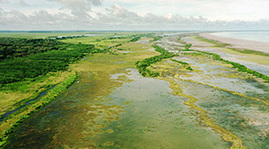
 Following the death of Peter Sculthorpe on Friday, our Music page now has a fuller appreciation of his life and work, and some reflections from people who knew him.
0 Comments

Peter Sculthorpe was Australia's foremost composer, and the first to create a truly Australian musical voice. It was on his return from studying in Oxford that Sculthorpe decided that his western musical heritage needed to make room for other influences, and these included aboriginal meoldies, the sounds of nature, and influences from neighbouring Asian countries.
Pieces such as the 1960s series Irkanda - “scrub country’ and Kakadu (1988) established him as the country’s leading painter of landscapes in sound. The vastness and silence of the outback, or the thronging of Australia’s wetlands, became his primary influences. He, in turn, became an environmental activist, contrasting the aboriginal peoples’ sense of being part of nature with the negative impact wrought by the arrival of Europeans. He worked closely with aboriginal musicians, most notably didjeridu virtuoso William Barton, for whom he wrote Earth Cry, a piece that exploits traditional imitative music to invoke the sounds of wildlife such as magpie geese. 
Kakadu, named after the famous National Park in the Northern Territory, is a typical example of his response to landscape and his use of native music. “This enormous wilderness area stretches from coastal tidal plains to rugged mountain plateaux, and in it may be found the living culture of its Aboriginal inhabitants, dating back for fifty thousand years. Sadly, today there are only a few remaining speakers of kakadu or gagadju. The work, then, is concerned with my feelings about this place, its landscape, its change of seasons, its dry season and its wet, its cycle of life and death.”
|
WelcomeFollow us on
Facebook and Twitter Email us Archives
October 2018
Categories
All
|

 RSS Feed
RSS Feed
